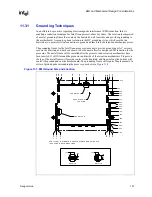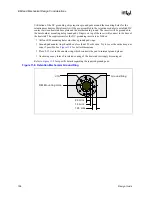
Platform Power Delivery Guidelines
166
Design Guide
12.2.4.3
Fault Protection
When looking for a VR solution, you can look for some fault protection features. The features help
the VR to prevent damage to itself and the circuits it powers. The VR should provide over-voltage
protection (OVP) by including a circuit, separate from the voltage sense path, capable of shutting
off the output drive when the output voltage rises beyond Vtrip. The power input (12 V) should be
protected with a fuse rated not greater than 30 A that sustains all operating and inrush conditions,
and that “blows” only for catastrophic failure of the VR. The VR should be capable of withstanding
a continuous, abnormally low resistance on the output without damage or over-stress to the unit. If
the VR goes into a shutdown state due to a fault condition on its output (not an internal failure), it
should return to normal operation after the fault has been removed, or after the fault has been
removed and power has been cycled off and on.
12.2.5
VR Module 9.1 Recommendations
Intel has defined VRM 9.1 for supplying VCC_CPU power to Intel Xeon processor based systems.
The VRM 9.1 definition includes Remote-Sense, Current Share, and Output Enable features. VRM
9.1 suppliers must provide these features and must meet voltage and current requirements set forth
in the
VRM 9.1 DC-DC Converter Design Guidelines
.
The VRM 9.1 Module, which provides VCC_CPU supply to the Intel Xeon processor, has the
capability of supplying a broad range of voltages (+1.1 V to +1.85 V).
It is highly desirable in DP applications that a current-sharing capability be available. The
VRM 9.1 covers the specification for supporting this feature. A VRM 9.1 designed for current
sharing must be capable of continuously producing a current that is higher than the rated value by a
factor of half of the current sharing accuracy. For example, if a particular VRM 9.1 is designed to
supply a 50 A processor as a maximum with 10% accuracy, the difference between the output
currents of two or more VRM 9.1s in parallel may be as much as 5 A at any value of current
actually produced, even to the point where one VRM 9.1 is producing 5 A, and one in parallel with
it is producing no current in supplying a 5 A load. This is necessary to insure that the higher-current
VRM 9.1 in a current-sharing pair does not operate above its limits due to current sharing errors.
One pin of the VRM 9.1 is reserved for current sharing control for a VRM 9.1 designed for star-
point or single-wire current sharing, i.e., Ishare. This pin will be connected to other VRM 9.1s
within the system.
The VRM 9.1 output slew rate is specified at 50 A/µs. The slew rate for the Intel Xeon processor is
450A/µs at the socket pins. The system designer must provide adequate bulk and high-frequency
decoupling on the motherboard to meet the appropriate processor required slew rate.
shows the recommended implementation of logic for monitoring the VID pins of all
processors. This logic will determine that all of the installed processors are requesting the same
VCC. If mixed voltage processors are detected, the output enable signal (OUTEN) of all VRM 9.1s
must be disabled. Note that if a processor is not installed, the VID[4:0] of that processor are all
high, and this should not cause disabling of the output of other VRM 9.1s. The VID lines must be
pulled up internally in the VR.
Summary of Contents for Xeon
Page 24: ...Introduction 24 Design Guide This page is intentionally left blank ...
Page 30: ...Component Quadrant Layout 30 Design Guide This page is intentionally left blank ...
Page 52: ...Platform Clock Routing Guidelines 52 Design Guide This page is intentionally left blank ...
Page 66: ...System Bus Routing Guidelines 66 Design Guide This page is intentionally left blank ...
Page 118: ...Intel 82870P2 P64H2 118 Design Guide This page is intentionally left blank ...
Page 146: ...I O Controller Hub 146 Design Guide This page is intentionally left blank ...
Page 148: ...Debug Port 148 Design Guide This page is intentionally left blank ...
Page 210: ...Schematic Checklist 210 Design Guide This page is intentionally left blank ...
Page 220: ...Layout Checklist 220 Design Guide This page is intentionally left blank ...
Page 222: ...Schematics 222 Design Guide This page is intentionally left blank ...















































